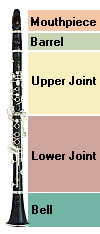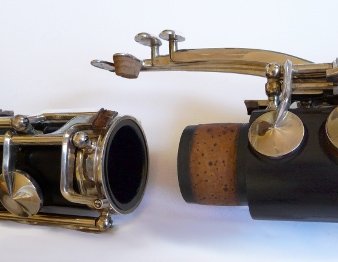Clarinet: The Instrument
The five parts all clarinets consist of

The mouthpiece with the reed is where the vibration that causes the tone is created. The mouthpiece is usually made of hard rubber (resonite), plastic, glass or crystal, sometimes of metal. The reed is fixed onto the mouthpiece with a ligature that uses screws or a simple cord (on the German style instruments).
The barrel or socket is the part that connects the mouthpiece with the upper body part. Usually the instrument comes with two barrels, one that is a little longer and one that is a little shorter. This is used to fine tune the instrument and to adapt it to the player and the orchestra's pitch.
Then you have the upper joint with the keys for the left hand and the lower joint with the keys for the right hand - both parts could be made from one piece, and some modern clarinets do have them built in one piece, but having them as two parts makes it easier to handle, to transport and to repair
The bell is responsible for the dispersion of the sound of the lowest tones.
This division into five parts is the same for all clarinets starting from the smallest up to the biggest. Separating the parts makes it easier to store them in a smaller case and if something breaks you only have to replace a smaller part.
Cork tenons to connect them all

The parts are connected by corked tenons (modern and cheap instruments, often made of ABS or resin, sometimes have the cork replaced by two rubber rings that sit in indentions). Together the parts form a wooden tube - the so called bore - that is nearly perfectly cylindrical (same diameter over the full length). Only in the upper part of the mouthpiece, where the reed is fixed, it is a little narrower and then close towards the funnel-shaped bell it opens wider (usually the widening starts already in the lower joint). Because the diameter of the bore and therefore of the instrument is standardized for all clarinets of the same type, the clarinet maker can replace parts rather easily. Usually even B flat and A clarinets come in exactly the same width (sometimes even across brands), so you can switch barrels and mouth pieces and thus having already warm parts and played-in reeds when having to change instruments during a concert.
... and it's body is made of wood ...
Generally the body of the instrument consists of hard wood, usually african blackwood - sometimes called grenadill. Its black wood is often confused with - but not the same as - Ebony. The natural colour of this wood is very dark brown or black, sometimes it is dyed black, too, so the parts appear to be of the same piece of wood and the instruments in the orchestra look the same. The wood is bought as blocks, then sawed (sometimes chopped with an axe) into smaller blocks of fitting size and then stored under standardized conditions (heat, humidity) for some years (in order to prevent later cracking). Then the bore will be drilled into the parts, the wood will be inspected for cracks again and if everything is looking good, the final shape and the tone holes will be applied.
... or other materials like rubber, plastic or resin ...
There are, too, instruments made from hard plastics like resonite, a rubber product, that is widely used for mouth pieces. Already in the 1930s German clarinet makers experimented with Plexiglas (for the band of the Africa Corps). Some instruments are made of metal, these are rare and they are said to have a different sound. Today new materials emerge like the "Green Line", that uses Ivory powder and carbon fibre glued together with a special resin as a combined material that should have the same physical characteristics as wood, except that it is not cracking...
... and the keys are forged of German silver
The key system, that closes and opens the key holes, is made from metal, usually "German Silver" (a nickel and brass alloy) for the levers and cups, with steel springs. Usually the metal parts are covered with a thin silver layer (takes some effort to keep shiny), sometimes nickel is used (simple, cheap, very good for gliding, but bad if you happen to develop allergies against it, and about 30% of the people do), sometimes gold (looks differently and is expensive, but said to be good for gliding).
There are parts like pads that are usually made from fine leather, silicone or cork, but today there are a lot of experimental materials around, too. The same is true for cushions on the ends of keys.
This YouTube video by Linsey Pollack shows that clarinets can be made from almost any material:
Videos by clarinet makers
There are good videos on the Internet about the industrial production of clarinets.
Clarinet production at Schreiber:
Clarinet production at French Buffet & Crampon: